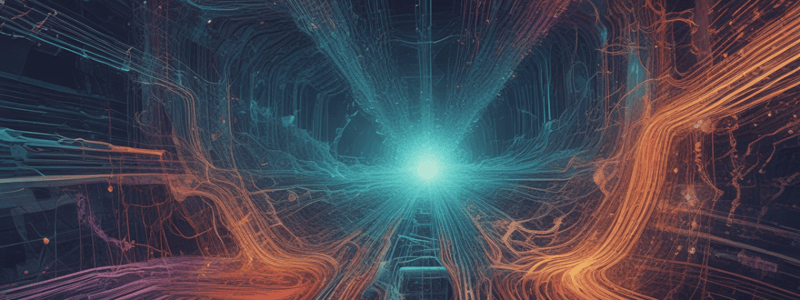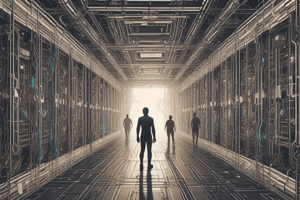Podcast
Questions and Answers
What do the top layers of deeper CNNs predict more accurately than 'regular-deep' models?
What do the top layers of deeper CNNs predict more accurately than 'regular-deep' models?
- Challenge images for AlexNet
- Early phases of IT neural responses
- Late phases of IT neural responses (correct)
- Recurrent circuits of the ventral stream
What has been observed for challenge images when using deeper CNNs?
What has been observed for challenge images when using deeper CNNs?
- The challenge images remain the same
- An increase in the number of challenge images
- A reduction in the number of challenge images (correct)
- No change in the number of challenge images
What is unique about the images that remain unsolved by deeper CNNs?
What is unique about the images that remain unsolved by deeper CNNs?
- They have shorter OSTs in the IT cortex
- They are not related to challenge images
- They have longer OSTs in the IT cortex (correct)
- They have no OSTs in the IT cortex
What does CORnet model implement?
What does CORnet model implement?
What is unique about Pass 4 of the CORnet model?
What is unique about Pass 4 of the CORnet model?
What do the results of CORnet model further argue for?
What do the results of CORnet model further argue for?
What do the data not yet explain?
What do the data not yet explain?
What is the number of time-steps implemented in the CORnet model?
What is the number of time-steps implemented in the CORnet model?
What happens when an image is rapidly followed by a spatially overlapping mask?
What happens when an image is rapidly followed by a spatially overlapping mask?
What is a limitation of standard feed-forward models like AlexNet?
What is a limitation of standard feed-forward models like AlexNet?
What is the purpose of adding recurrent connections to the fc7 layer of AlexNet?
What is the purpose of adding recurrent connections to the fc7 layer of AlexNet?
What is a characteristic of attractor networks like the Hopfield network?
What is a characteristic of attractor networks like the Hopfield network?
What was observed when evaluating the performance of feed-forward models on partially visible objects?
What was observed when evaluating the performance of feed-forward models on partially visible objects?
What was found when comparing the latency of neural response and computational distance of each partial object to its whole object category mean?
What was found when comparing the latency of neural response and computational distance of each partial object to its whole object category mean?
What is the name of the model that was developed by adding recurrent connections to the fc7 layer of AlexNet?
What is the name of the model that was developed by adding recurrent connections to the fc7 layer of AlexNet?
What is shown in the temporal evolution of the feature representation for RNNh as visualized with stochastic neighborhood embedding?
What is shown in the temporal evolution of the feature representation for RNNh as visualized with stochastic neighborhood embedding?
What is the primary advantage of deeper CNNs like Inception-v3 and ResNet-50 compared to shallower networks like AlexNet?
What is the primary advantage of deeper CNNs like Inception-v3 and ResNet-50 compared to shallower networks like AlexNet?
What is the primary function of recurrent computations in the primate brain during core object recognition?
What is the primary function of recurrent computations in the primate brain during core object recognition?
What is the primary purpose of pattern completion in perception?
What is the primary purpose of pattern completion in perception?
What is the result of backward masking on visual object recognition?
What is the result of backward masking on visual object recognition?
What can be inferred from the representation of whole objects and partial objects in the study?
What can be inferred from the representation of whole objects and partial objects in the study?
What is the minimum percentage of object visibility required for the visual system to make inferences?
What is the minimum percentage of object visibility required for the visual system to make inferences?
What happens to the representation of partial objects over time in the clusters of whole images?
What happens to the representation of partial objects over time in the clusters of whole images?
What is the primary finding of Tang et al.'s (2018) study on pattern completion?
What is the primary finding of Tang et al.'s (2018) study on pattern completion?
What is the timing of the saturating performance and correlation with humans in the RNNh model?
What is the timing of the saturating performance and correlation with humans in the RNNh model?
What is the result of visual categorization of objects under limited visibility?
What is the result of visual categorization of objects under limited visibility?
What is the effect of backward masking on the RNN model's performance?
What is the effect of backward masking on the RNN model's performance?
What is the primary difference between the visual system and current computer vision models?
What is the primary difference between the visual system and current computer vision models?
What cognitive process is critical for recognition of poorly visible or occluded objects?
What cognitive process is critical for recognition of poorly visible or occluded objects?
What is the timing of the physiological responses to heavily occluded objects?
What is the timing of the physiological responses to heavily occluded objects?
Flashcards are hidden until you start studying
Study Notes
Deeper CNNs and IT Neural Responses
- Deeper CNNs, such as Inception-v3 and ResNet-50, predicted IT neural responses at late phases (150-250 ms) more accurately than shallower models like AlexNet.
- This suggests that deeper CNNs might be approximating 'unrolled' versions of recurrent circuits in the ventral stream.
- Deeper CNNs had fewer challenge images, and the remaining challenge images showed longer OSTs (object-selective tolerance) in the IT cortex.
CORnet Model
- CORnet is a four-layered recurrent neural network model that better predicts IT responses, especially in the late phase.
- The top layer of CORnet has within-area recurrent connections with shared weights and implements five time-steps.
- Pass 1 and pass 2 of the network are better predictors of early time bins, while late passes (especially pass 4) are better at predicting late phases of IT responses.
Recurrent Computations in the Ventral Stream
- Deeper CNNs partially approximate recurrent computations in the ventral stream, which are more efficiently built into the primate brain architecture.
- During core object recognition, recurrent computations act as additional nonlinear transformations of the initial feedforward process.
Image Completion and RNN
- Recurrent computations are necessary for visual pattern completion, enabling recognition of poorly visible or occluded objects.
- The visual system can make inferences even when only 10-20% of the object is visible.
Backward Masking
- Backward masking disrupts recognition of partially visible objects by interrupting processing of the visual stimulus.
- Behavioral performance declined at limited visibility, and standard feed-forward models were not robust to occlusion.
RNNh Model
- The RNNh model, which added recurrent connections to the fc7 layer, demonstrated a significant improvement over the standard AlexNet architecture.
- The RNNh model's performance and correlation with humans saturated at around 10-20 time steps.
- The model's performance was impaired by backward masking, reducing it from 58 ± 2% to 37 ± 2%.
Studying That Suits You
Use AI to generate personalized quizzes and flashcards to suit your learning preferences.




